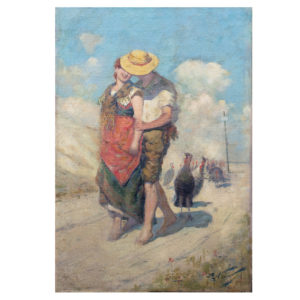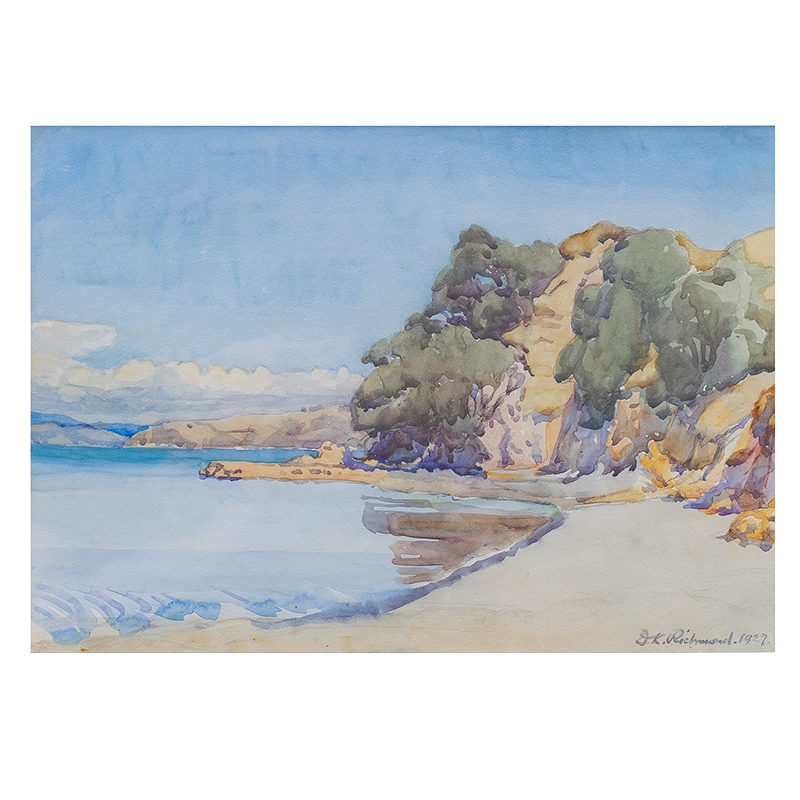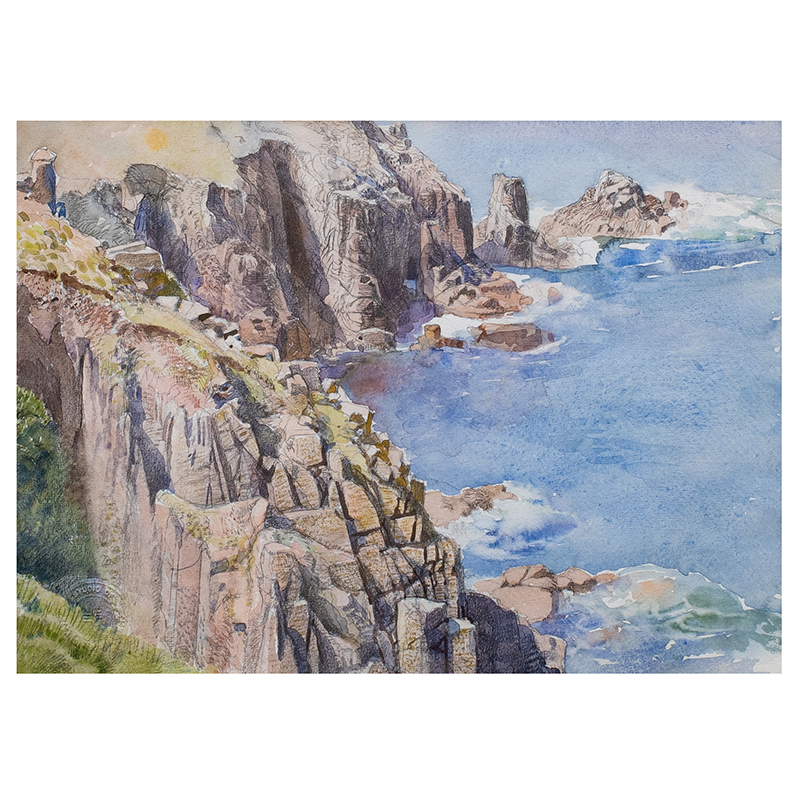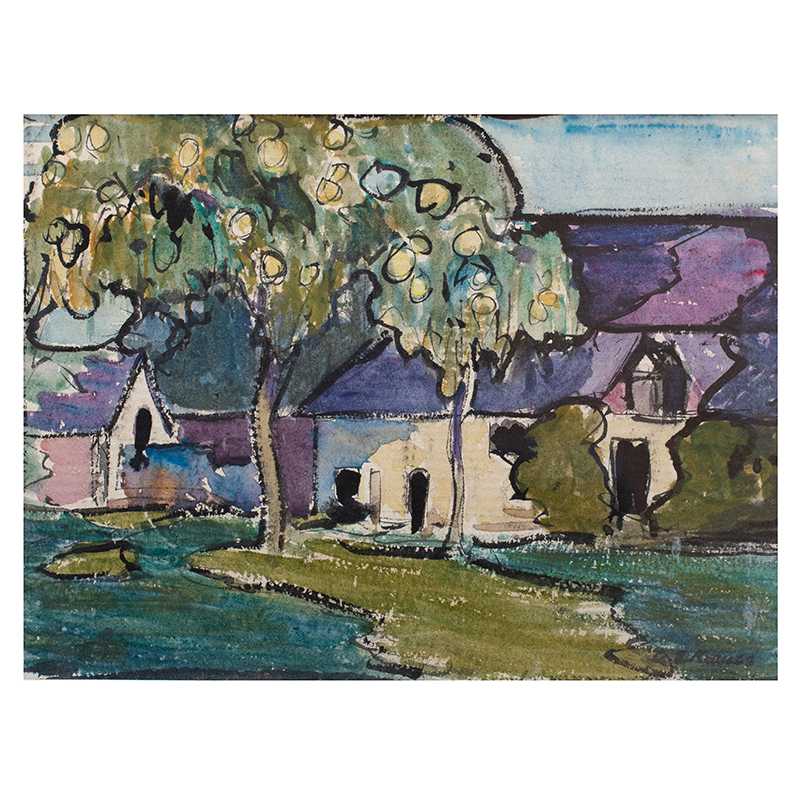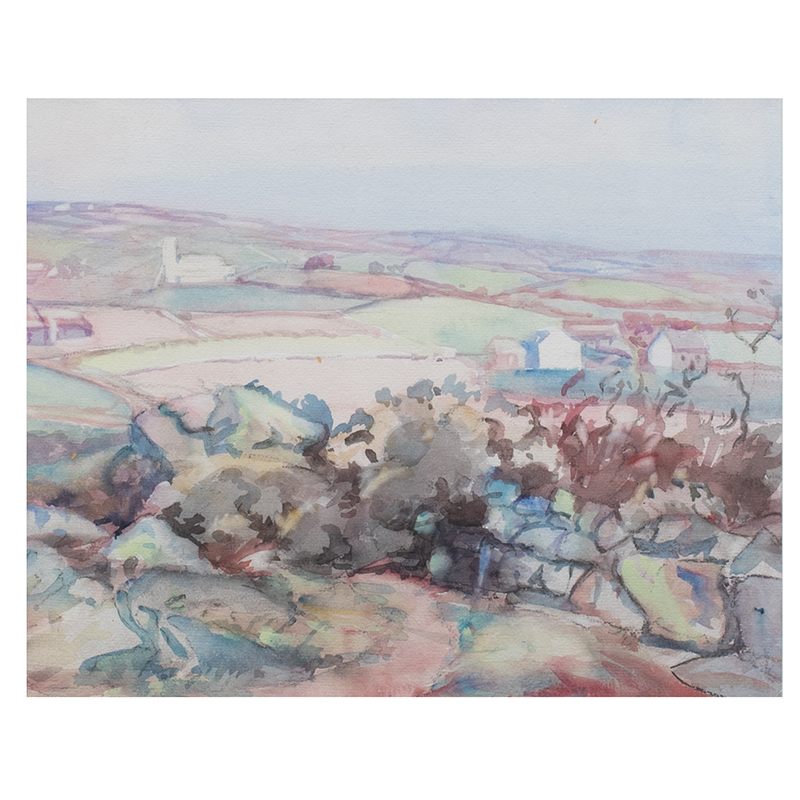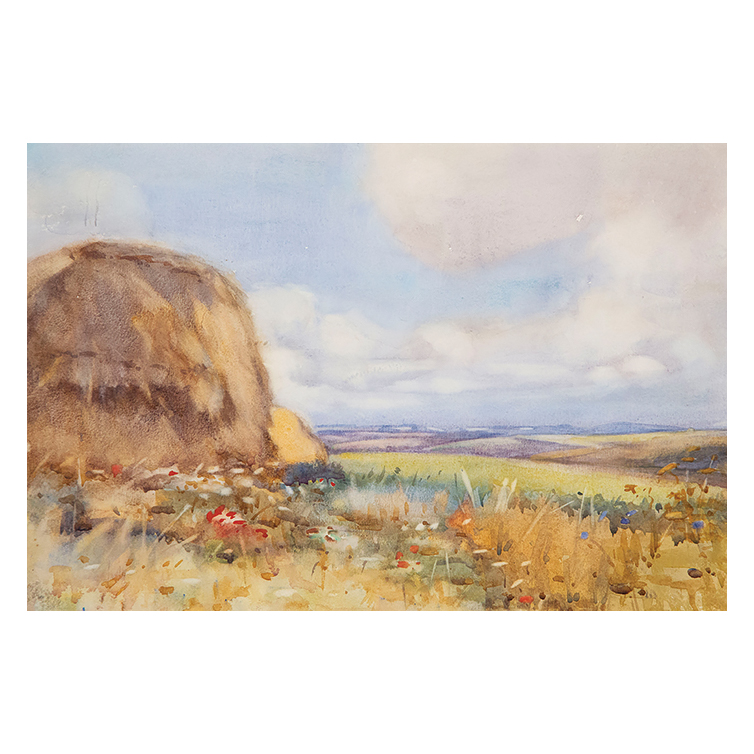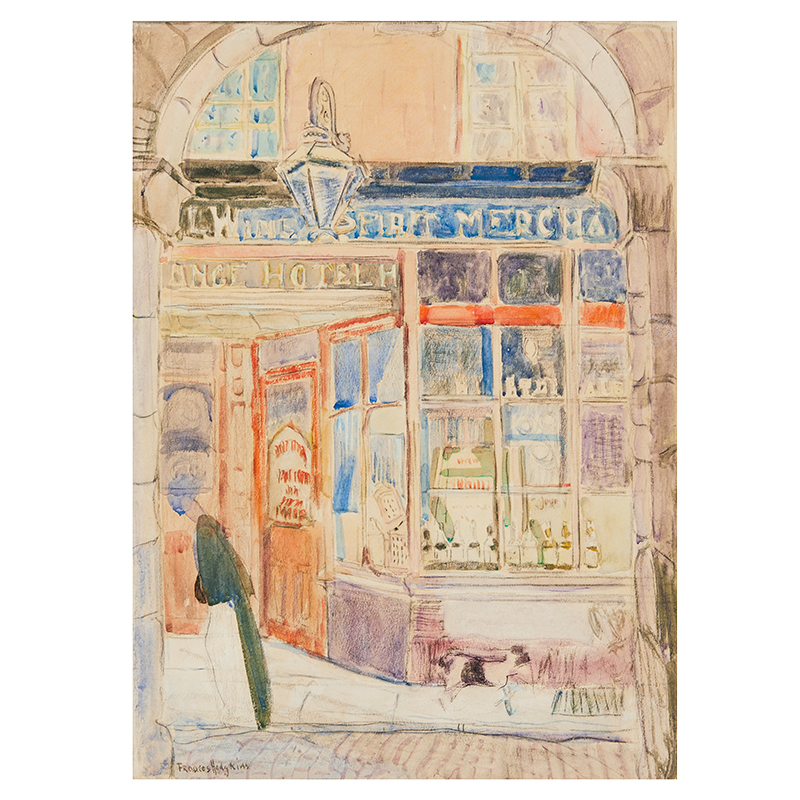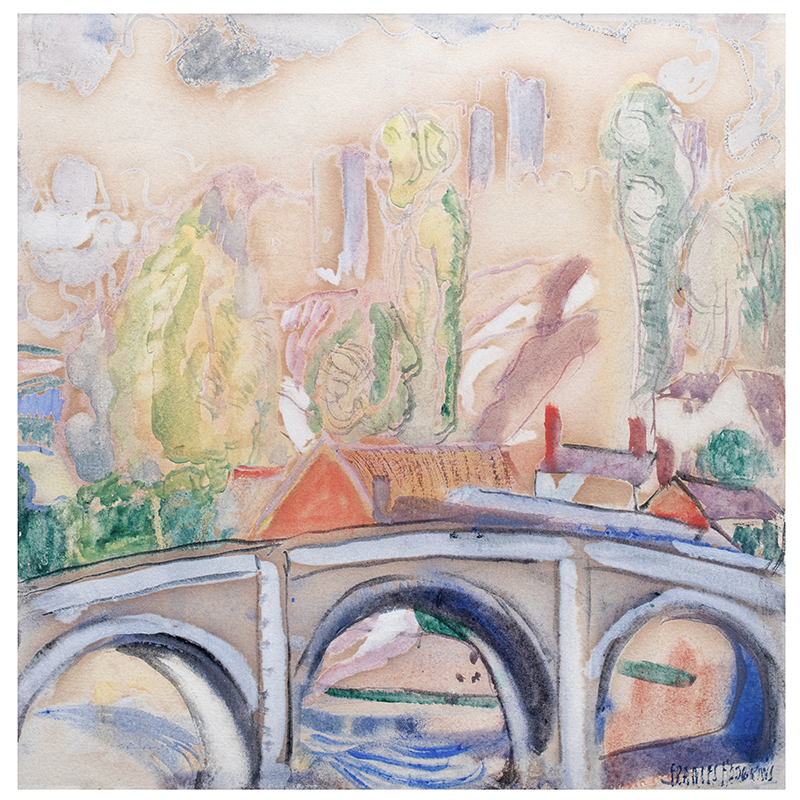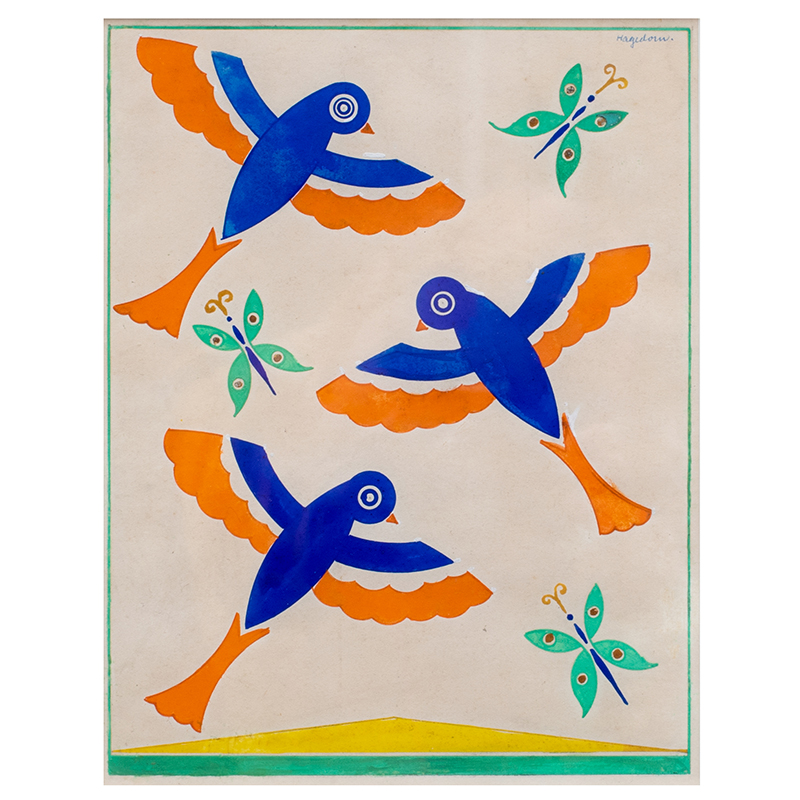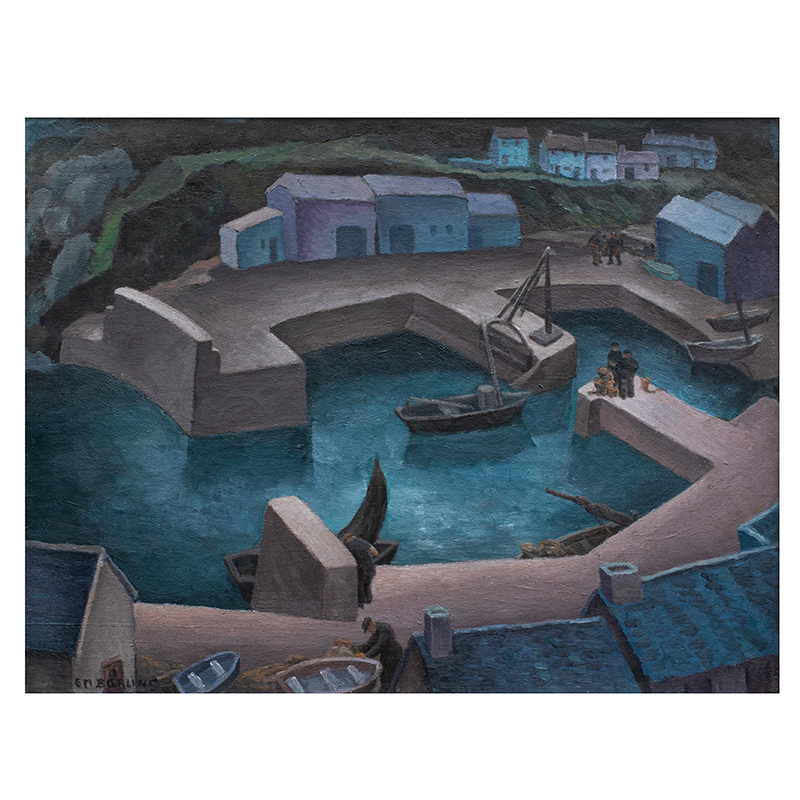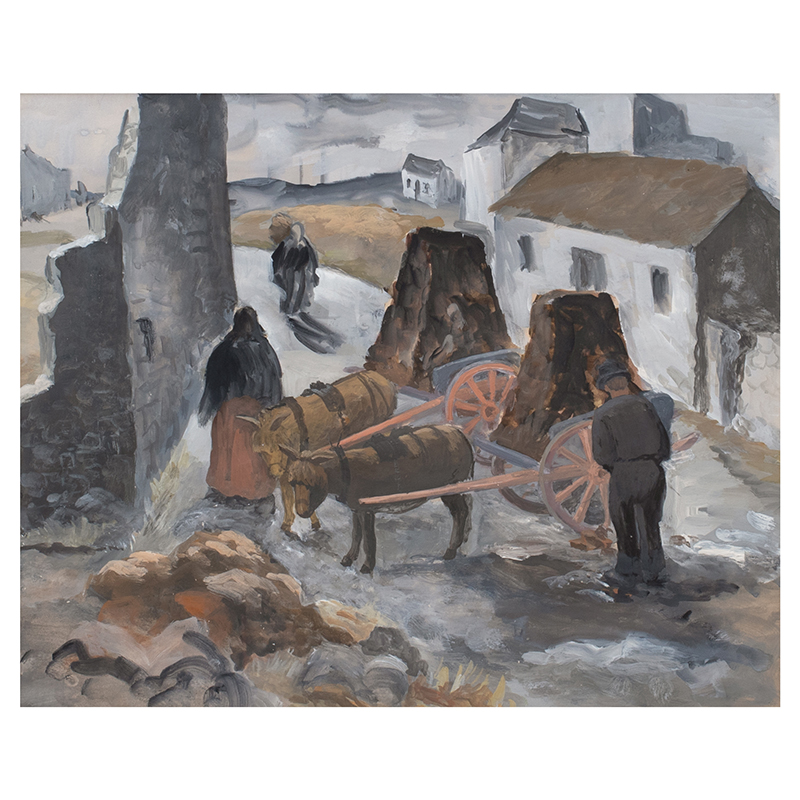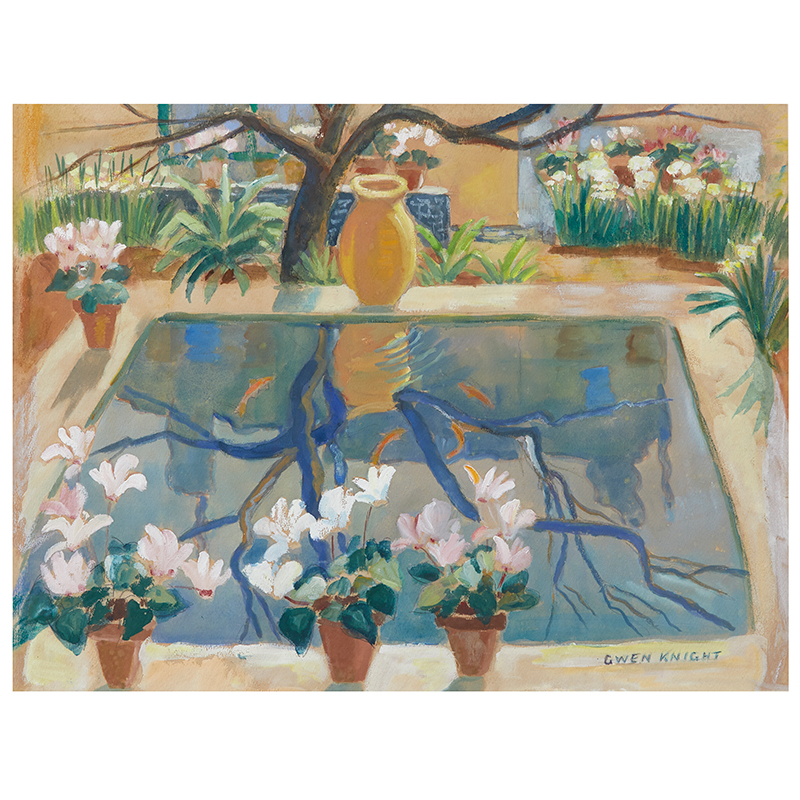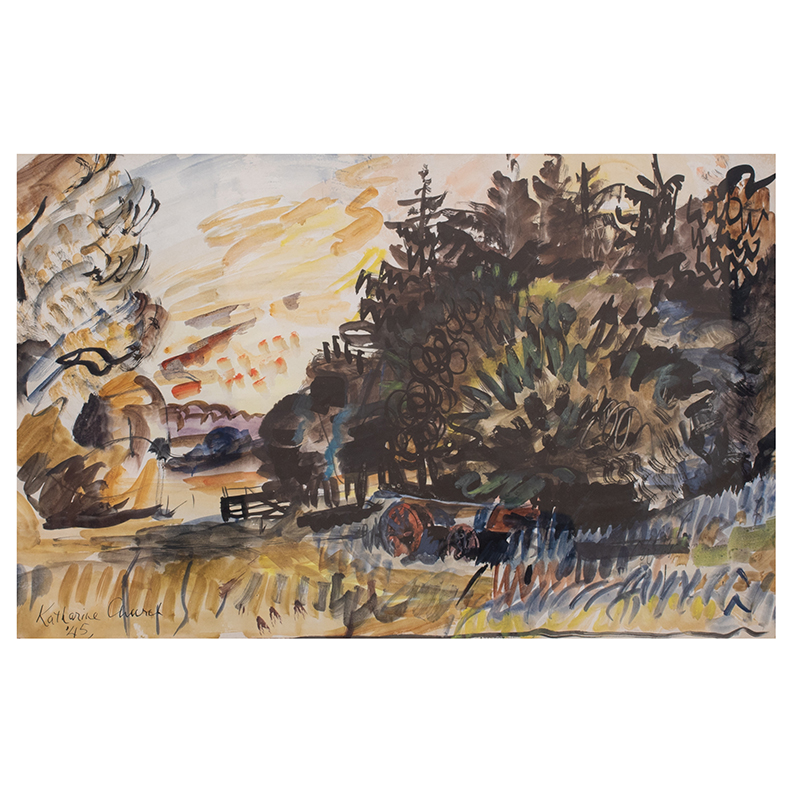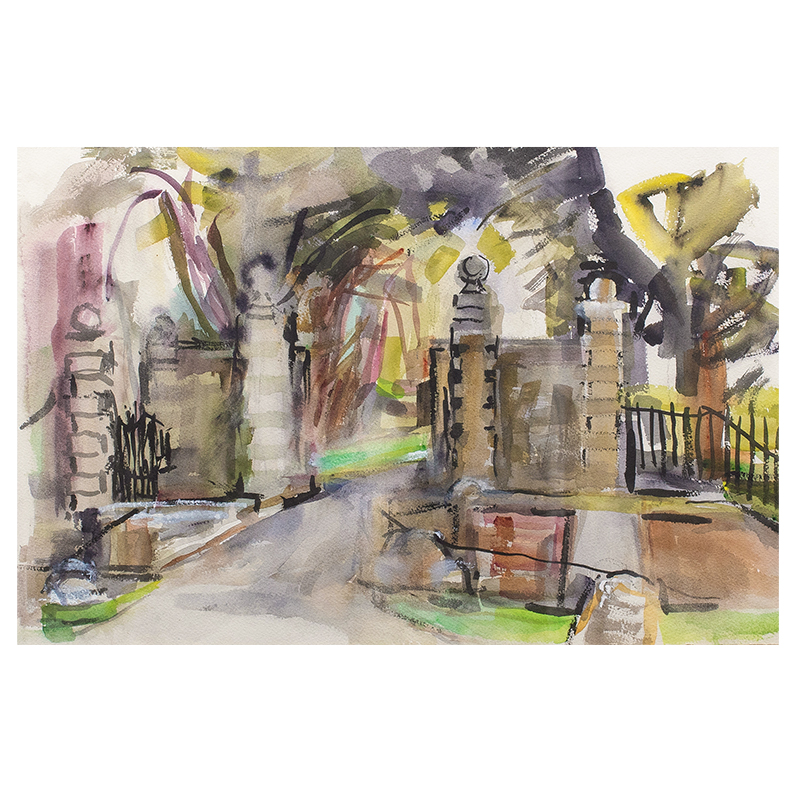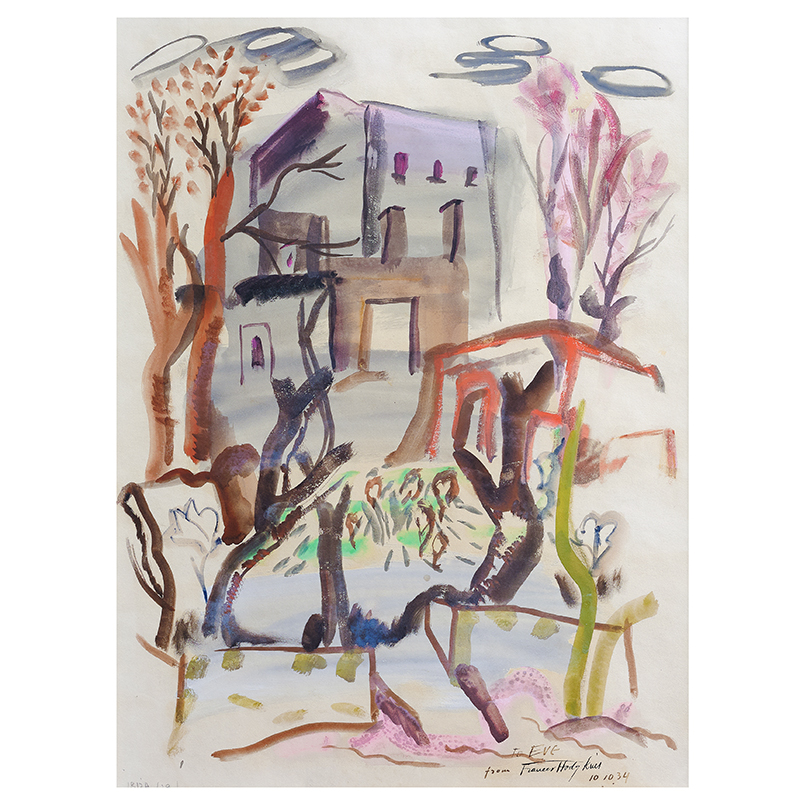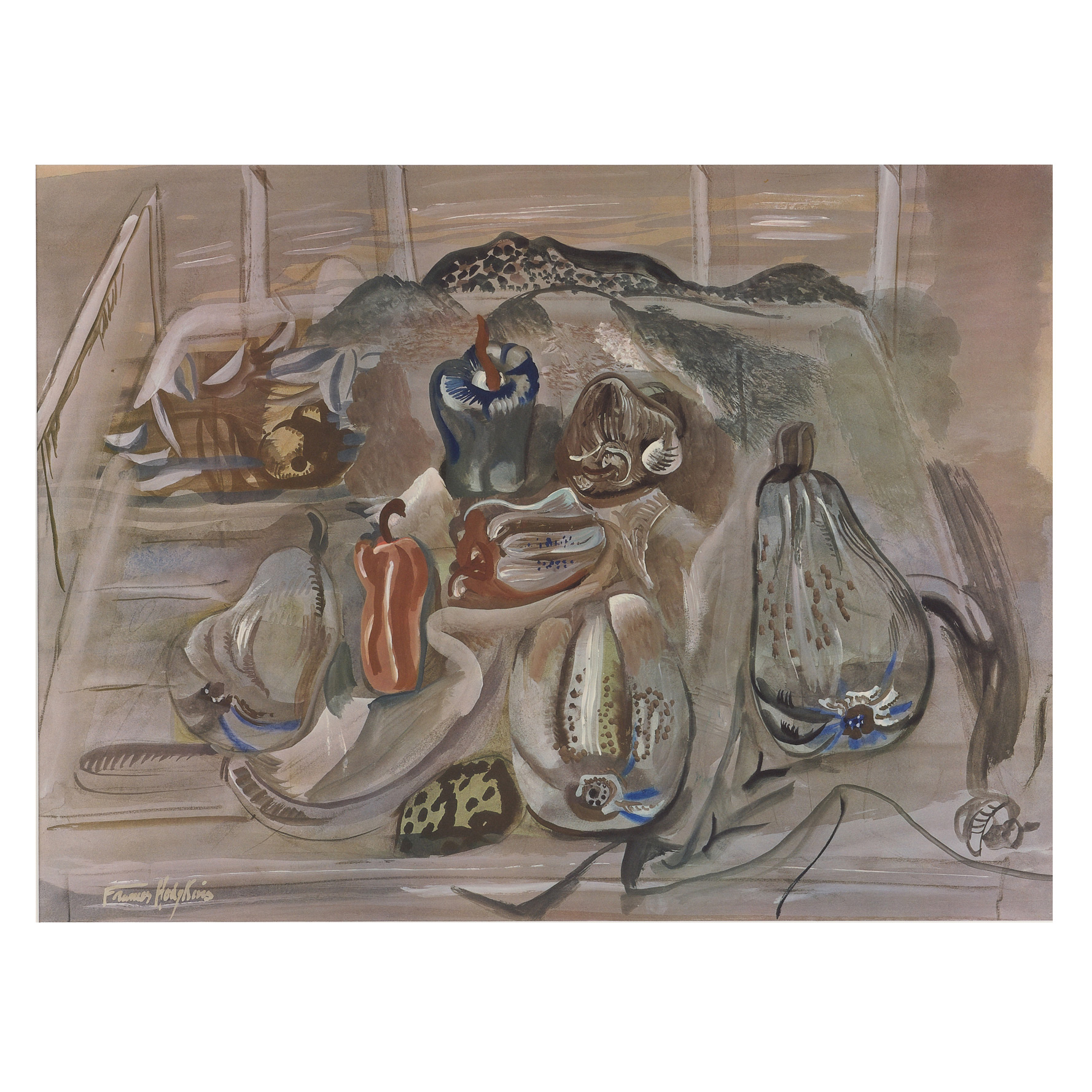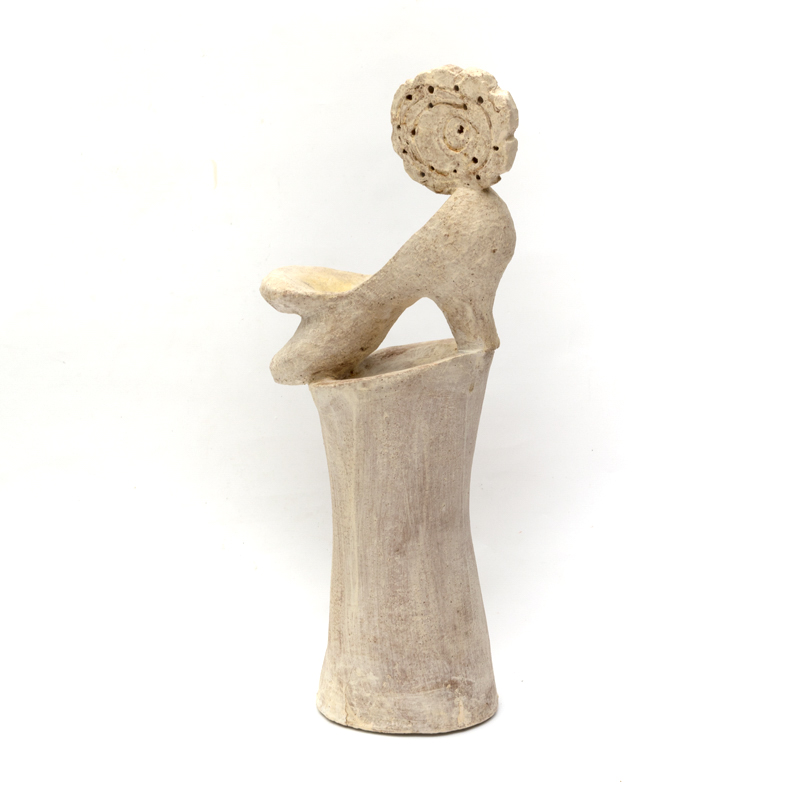Blog
FRANCES HODGKINS
and Her Circle
12 November - 6 December
Three years in the making Frances Hodgkins and Her Circle is an exhibition that explores and celebrates the importance of community. At its core is an artist who had the enigmatic quality of drawing people to her. Over the course of seven decades Frances Hodgkins established a confrère of loyal supporters and friends. These relationships would prove vital in not only the development of her career, but also in turn the establishment of a number of significant artistic vocations for artists such as Owen Merton, Dorothy Kate Richmond, Beatrice Seddon and Amy Krauss. Hodgkins’ own career was in turn influenced by her friendship with artists such as Cedric Morris & Lett Haines, critics and writers John and Myfanwy Piper and art dealers Lucy Wertheim, Duncan Macdonald and Arthur Howell.
Artists
_
FRANCES HODGKINS AND HER CIRCLE
12 November - 6 December 2020
Hodgkins individuality and ability to inspire fostered the development of lifelong friendships. Her students became friends, friends became collectors, and collectors in turn supported her and promoted her work ceaselessly. The respect and admiration felt by many is clearly evident in Frances’ correspondence. She wrote frequently to family and friends and reading through her correspondence one gets a rare insight into the remarkable relationships that the artist forged.
One of the first and perhaps most significant influences on her career was that of her older sister, Isabel Hodgkins. The two were particularly close and she valued Isabel’s opinion greatly. Shortly after arriving in Italy in 1902 she wrote to Isabel;
‘My dearest old girl Words can’t tell you how happy your last two letters made me. Such dear letters full of warm generous sympathy, tho‘ far, far too much praise. It rejoiced my heart to hear that you approved of my work. I care so dreadfully for your & Dr. Scott’s opinion and I hardly dared open your letter’.
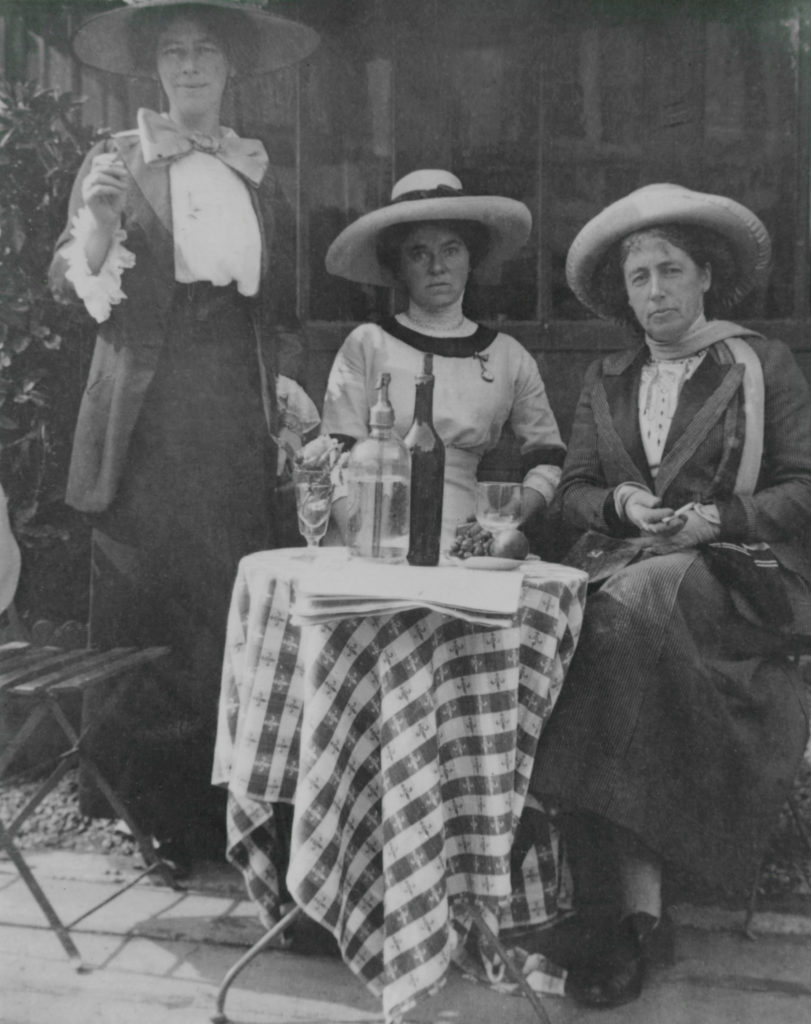
Frances Hodgkins with Two of Her Pupils at St Valery-sur-Somme
E H McCormick Papers, E H McCormick Research Library, Auckland Art Gallery Toi o Tāmaki, gift of Linda Gill, 2015
The development of her own career was singularly important to Hodgkins. She extended her practice and continued herstudy in France by enrolling in Penzance-based artist Norman Garstin’s sketching classes. During their association Garstin introduced Hodgkins to a number of leading British artists, including Stanhope Forbes and Lamorna Birch. It is during thisperiod that she also formed a close friendship with fellow New Zealand artist Dorothy Kate Richmond. After arriving in theartist’s colony of Dinan, Brittany, she wrote to her mother,
‘I found Miss Richmond already installed when I arrived and winning all hearts by her sweetness & beauty … I am a lucky beggar to have her for a travelling companion. She is so restful & sweet and I think we suit each other well’.
They travelled together in Europe on many occasions, painting together in France and Italy. On their return to New Zealand in1906, they set up a studio in Bowen Street, Wellington where they exhibited 80 of their European paintings together.
In order to appreciate the importance of the relationships she formed with some of the artists featured in this exhibition one has only to look at the significant body of portraits of friends andbenefactors in Hodgkins’ oeuvre. There are two paintings by Elsie Barling in this exhibition and the close relationship between Hodgkins and her former students who later became lifelong friends is borne out by the eloquent drawing of Barling (Auckland Art Gallery Toi o Tāmaki). Drawn whilst Hodgkins, Barling and Dorothy Selby were staying in a cottage in Sussex in 1929, the portrait captures Elsie as she descended a staircase. Hodgkins later gave the portrait to Selby as a Christmas present in 1931, inscribing on the mount “Of a friend to a friend by a friend”.
Hodgkins also painted two outstanding ‘double’ portraits of friends and supporters Hannah Ritchie & Jane Saunders and Katharine & Anthony West. Ritchie and Saunders, both students of Hodgkins since 1911 and 1912, drew her into theirmilieu of influential literary and artistic friends in Manchester. Their network included Forrest Hewit, chairman of the Calico Printers’ Association, who helped her secure a job as a designer on a salary of £500 a year. The double portrait of Hannah Ritchie and Jane Saunders (Hocken Library, Dunedin) was commenced in Manchester in 1922 and finally finished and presented to her friends three years later.
Two of Hodgkins’ closest friends & benefactors later in life were Katharine and Anthony West. Frances stayed with the Wests on their farm on several occasions and in the autumn of 1941 recuperating there after surgery and they continued to send Hodgkins food parcels during the war years. Double Portrait No. 2, (Museum of New Zealand Te Papa Tongarewa) features the couple, painted from previous sketches made at Chisbury Manor in 1939. Katharine West was a well exhibited painter and several of her own paintings appear in this exhibition under her maiden name Katharine Church.
One of the more significant relationships to form over the course of her life was with artist and art critic John Piper and his wife, the writer Myfanwy Evans. Frances wrote to them in May 1940
‘… I was made so very happy by what you & John wrote about me and I owe you very particular thanks. It gave to my show all the success I could hope for it … Goodness & Beauty must persist dear Myfanwy & Love is the keynote. When shall we meet again? Soon I hope - All my love Frances’
Piper often reviewed Hodgkins exhibitions and Myfanwy was commissioned by Sir Kenneth Clark to write on her career for the Penguin Modern Painters series.
One of the longest and perhaps greatest friendships in Hodgkins time in England was with potter, Amy Krauss, who had first studied under Hodgkins in St Ives in 1915. When Hodgkins was living in ‘an old stone barn’ in Burford in 1923 she invited Amy to come to Burford with a crate of pottery and her wheel and found her a shop in the village in which to sell her pottery. Hodgkins described Amy thus, ‘everyone likes her – she is a downright good sort & extremely capable – both as a painter & potter. Earns her living like all of us’.
Later, in 1936 once again searching for new pastures in Dorset, Frances stayed for a few weeks at Amy’s home Redlane Cottage in East Street, Corfe Castle. Returning again in May 1936 after her trip to Spain, Frances wrote to Duncan Macdonald that she was looking for ‘a quiet corner where I can chrystallize the afterglow of my Spanish memories – before they grow dim’. Staying at Amy’s cottage in East St and working out of her rented disused Wesleyan Chapel studio in West St, conveniently just a short walk through the village allotments cutting through a narrow passage into West street just behind her studio.
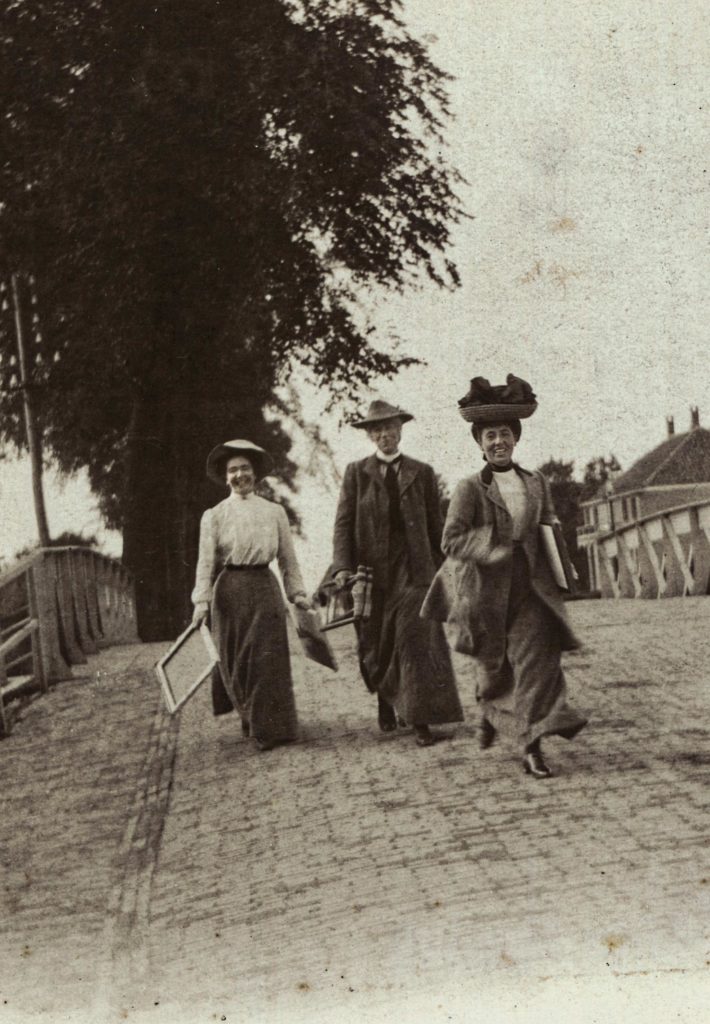
Rosamond Marshall, Dorothy Kate Richmond and Frances Hodgkins in Rijsoord, Holland, 1903
E H McCormick Papers, E H McCormick Research Library, Auckland Art Gallery Toi o Tāmaki, gift of Linda Gill, 2015
Amy played a pivotal role in Hodgkins’ life. It was Amy who picked her up from the West’s farm after her recuperation from surgery in August 1941 and cared for her at Redlane Cottage until she was fit enough to return to her own cottage and studio in West Street, Corfe Castle. It was Amy who drove her up to London on the closing day of her final exhibition, the Retrospective at Lefevre Gallery in 1946. They were escorted around the gallery by Duncan Macdonald and by chance met Jane Saunders who was also visiting the exhibition. Amy’s final act of their enduring friendship was to arrange the return of Frances’ ashes to her family in New Zealand after her funeral in Dorset in 1947.
In this small catalogue it is impossible to mention all of the artists, friends, supporters and gallery owners who cherished and supported Frances Hodgkins. This exhibition brings together a series of works dating from 1888 to 1987 and while the exhibition focusses on the relationship between Hodgkins and her circle of friends and fellow artists, it also acknowledges the outstanding career of a number of prominent 20th century New Zealand and British artists. Upon their return to Aotearoa with fresh ideology and overseas experience, the influence of her students Dorothy Kate Richmond, Gwen Knight, Edith Collier and Flora Scales, to name but a few, cannot be underestimated. Their skill and particularly their ability to teach European Modernism and illustrate these ideas in their works had a profound effect on the development of New Zealand art in the 20th Century.
– Jonathan Gooderham
Isabel Jane Field
From Frances Hodgkins to Isabel Field, 12 November 1899, Castle St.
‘Your pictures are splendid! And I am glad to be able to tell you that one is sold. “Tranquill Waters” Dr Roberts bought it. It is simply wonderful to me how much you have improved and to every one else too – you must have been storing it all up and the result is beyond all expectations. I was prepared to be critical but I must confess I could only admire when I saw them’.
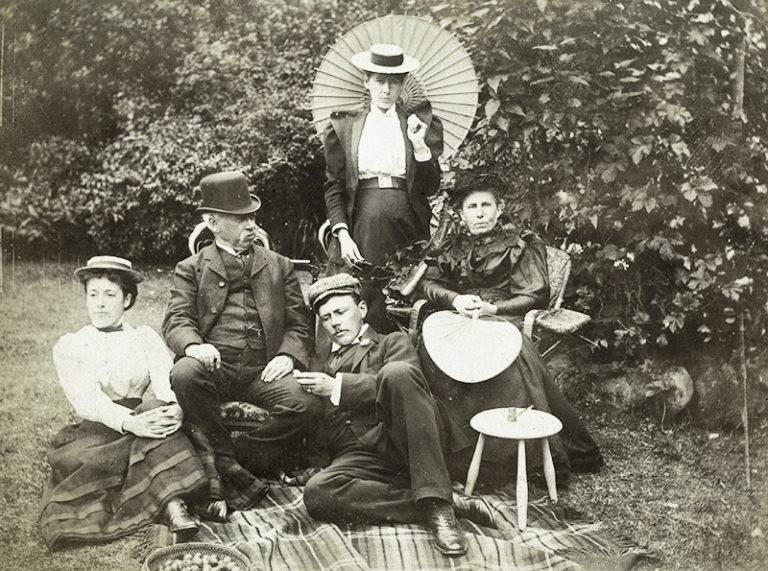
Hodgkins Family Group at Cranmore Lodge
E H McCormick Papers, E H McCormick Research Library, Auckland Art Gallery Toi o Tāmaki, gift of Linda Gill, 2015
Isabel Jane Field (née Hodgkins) (1867-1950) was born in Dunedin, the daughter of painter William Hodgkins and older sister of Frances Hodgkins. Isabel inherited her father’s talents and grew up in a household where a dedicated, almost professional attitude to painting and exhibiting was a normal part of family life.
Isabel accompanied her father on sketching expeditions, received tuition from him and became a successful painter of landscape and still life. The early artistic promise she showed resulted in regular exhibitions from 1884 at the Otago Art Society and Canterbury Society of Arts, which brought her local and national success as a watercolour flower painter and landscapist. From that point she ranked with fellow Canterbury artist Margaret Stoddart in setting the standard for flower paintings. Reviewers competed to praise her ‘rare qualities for drawing and harmonious treatment of colour’ (Evening Star).
Marguerites, the watercolour illustrated here, is a beautiful example of Isabel’s work and demonstrates vividly why she was the first of the sisters to become a successful artist. The work attracted great praise in the Lyttleton Times when exhibited at the Otago Art Society’s annual exhibition in 1888.
‘The last of the ladies’ contributions is undoubtedly one of the most important pictures in the gallery. We refer to Miss Hodgkins’ study entitled “Marguerites” (229). This is not only beyond comparison, superior to any work of the kind here, but it stands on an altogether higher plane of art’.
Dora Meeson
From Frances Hodgkins to Isabel Field, 17 April 1899, Castle St.
‘I have had a long letter from Dora Meeson in Paris giving me much valuable information as to ways and means etc. Ways and means will be very costly next year in Paris on account of the Exhibition so she advises me to stay in London till after the rush is over ...’
-
Dora Meeson
Pulteney Bridge, Bath
Oil on panel 40 x 30 cm Signed Provenance Private collection Melbourne
Dora Coates (née Meeson) (1869-1955) was born in Melbourne on 7 August 1869, the eldest daughter of John Thomas Meeson, headmaster of Hawthorn Grammar School, and Amelia (née Kipling). The Meeson family were constantly on the move between 1876 and 1896, living in London, New Zealand and Melbourne, and Dora was mainly educated at home. The Meeson family were well known to Isabel and Frances Hodgkins in the early 1890s, whilst they were resident in Dunedin. Frances Hodgkins wrote on several occasions about socialising with the Meeson family to her mother, Rachel, and sister, Isabel.
Studying at the Canterbury College School of Art, Meeson began appearing in New Zealand exhibitions in 1890. She studied intermittently at London’s Slade School of Fine Art in 1892-3, at the National Gallery School, Melbourne 1895-6, then in Paris at the Académie Julian 1898-99. Returning to London in 1900, she married fellow artist George Coates in 1903. A move to Chelsea in 1906 saw Meeson resume her involvement with the suffrage movement. Meeson had signed the 1893 suffrage petition in New Zealand and actively campaigned for equality in both Australia and Britain, not least through her persuasive and ground-breaking political cartoons.
She became a founding member of the Women’s Freedom League (Kensington Branch), she was also a member of the Conservative and Unionist Women’s Franchise Association and the Artists’ Suffrage League. In 1912 she was a member of the London-based Australia and NZ Women Voters Committee and during the war was the Australian representative in London of the British Dominions Women’s Suffrage Union.
Girolarmo Nerli
From Frances Hodgkins to Isabel Field, 9 June 1893, Cranmore Lodge
‘I went to see Mr Cole’s studio today. I admire his work and his method tremendously but I think compared with Nerli his work is lifeless. What an artist a judicious blending of the two would make! Nerli has been most awfully good to me and gives me an extra lesson on Saturdays in his studio’.
-
Girolamo Pieri Nerli
The Springtime of Life
Oil on canvas 39 x 26.5 cm Signed c.1890 Provenance Private Collection, Auckland since c. 1960 Illustrated Peter Entwisle, Michael Dunn & Roger Collins, Nerli - An Exhibition of Paintings & Drawings, (Dunedin Public Art Gallery, 1988) p. 102 (engraving of this work)
Girolamo Pieri Pecci Ballati Nerli (1860-1926) was an Italian painter born into an aristocratic family in Siena. He studied art under Antonio Ciseri and Giovanni Muzzioli and emigrated to Australia in 1885. After a short stay in Melbourne he moved to Sydney, where he became associated with the Heidelberg School. He travelled to Samoa in 1892 where he painted the portrait of Robert Louis Stevenson.
Nerli first visited Dunedin in 1889 and settled there in 1893. A colourful figure, he became an influential teacher and exhibitor, with Frances Hodgkins and Grace Joel his principal protégées. In 1893 Nerli was elected to the council of the Otago Art Society and in 1894 he set up the Otago Art Academy along with J.D. Perret and L.W. Wilson in Dunedin’s Octagon.
Nerli was a charismatic teacher and his private classes were so popular that the Dunedin School of Art and Design decided to employ him as a teacher of painting. Having no particular specialty, he produced portraits, landscapes and genre compositions in an impressionistic, animated style which was new to Otago artists. He encouraged his students to look beyond the limitations and restraints of New Zealand art to the innovations of Europe. Nerli encouraged Hodgkins to focus on capturing the natural effects of colour and light by sketching en plein air and his influence can clearly be seen in the fluid watercolour handling of her early works.
Dorothy Kate Richmond
From Dorothy Richmond to Frances Hodgkins, 19 June 1901, Paris, Place du Trocadero
‘Your kind letter to hand last night I at once decided to come to Caudebec if Mr Garstin will have me. I am writing to him this morning. I am looking forward to meeting you with real hoy. I think companionship doubles the pleasure & halves the sorrows of life. Before I left N.Z. I had formed a strong wish to be with you in Paris ... Apart from companionship socially, I feel so very glad at the idea of seeing your painting. Your work is far better than that of any of the teachers I have seen since I came here’.
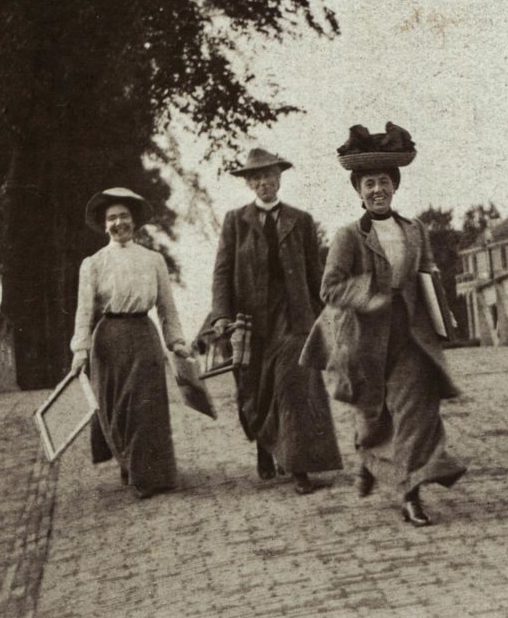
(Detail) Rosamond Marshall, Dorothy Kate Richmond and Frances Hodgkins in Rijsoord, Holland, 1903
E H McCormick Papers, E H McCormick Research Library, Auckland Art Gallery Toi o Tāmaki, gift of Linda Gill, 2015
Dorothy Kate Richmond (1861-1935) was born in Parnell, Auckland, to James Crowe Richmond and Mary Smith. Her father was a talented watercolourist and Dorothy followed his lead, training at the Slade School of Fine Art, London, 1878-80. On her return to Nelson in late 1880, Richmond was one of a small group of New Zealand-born women to have received a professional training in art. She became a member of the New Zealand Academy of Fine Arts in 1890, relocating to Wellington in 1894 with her father where she studied under James Nairn in 1896.
Richmond’s father was a close friend and painting companion of William Mathew Hodgkins and in the summer of 1898 she decided to leave New Zealand for Europe with the intention of meeting up with Frances. Richmond was a pivotal force in Hodgkins’ life during this period, introducing her to Irish painter Norman Garstin, whose advice, support and friendship she greatly valued. Both artists joined Garstin’s 1901 summer school at Caudebec and later travelled together to Britain, France, Italy and the Netherlands. Richmond and Hodgkins returned to New Zealand in 1903 and rented a studio in Bowen Street, Wellington, where they taught private pupils. In 1904 they mounted an exhibition of 80 of their European paintings at McGregor Wright Gallery in Lambton Quay. When Hodgkins returned to Europe in early 1906, Richmond kept both the Bowen Street studio and the private pupils.
Richmond became a prominent member of the New Zealand Academy of Fine Arts as a teacher and also exhibiting nationally. In this last role she influenced many other artists including Owen Merton. Richmond was greatly admired as a teacher and she continued exhibiting in Wellington, Auckland and Christchurch until 1934.
Seen somewhat stereotypically as a leading flower painter, she is in fact one of New Zealand’s key early twentieth century landscape artists. At Wellington’s annual art exhibition in 1928, her works drew the comment that ‘one of her watercolours among a thousand would be instantly recognised for the subtle beauty of its colour, often suggestive of the interior of pearl shell, and her sure, free and fluent drawing’ (Evening Post). Her apparently effortless renditions of the New Zealand landscape, nearly always in watercolour, show how attractive Naturalism could be, even as Modernism was claiming the headlines.
In selecting the time of day, season and weather in which a scene is at its most beguiling, she made enduringly beautiful paintings. At the same time an accurate likeness of place is delivered with exquisite effect. This makes her landscape watercolours of the 1920s and ‘30s wonderfully evocative for the present-day viewer who may know those scenes that she captured, but are unaware of the generally much more idyllic character they used to have a century ago.
Richmond’s subject illustrated here is one she knew very well, the bays lying on the north-eastern side of Wellington harbour, opposite the city, were a popular leisure spot for locals. This scene was repeated in other works by Richmond, such as Nelson Beach 1927 and Evening, York Bay 1934. The absence of human figures in her compositions indicates the artist’s true calling as a landscapist, inspired by nature rather than society.
Owen Merton
From Owen Merton to Frances Hodgkins, 12 April 1911, Ealing W.
‘I only want to say that I am so very delighted with those two water colours in the International. I think they are without any doubt the best work of yours I have seen. The lanterns especially. You are more of a marvell than ever - and I am so very proud of New Zealand and everything ... I am pretty certain to come to Concarneau again later on in the summer. I am only here a week or two and go back to Paris till July’.
Owen Heathcote Grierson Merton (1887-1931) was born in Christchurch and educated at Christ’s College, where he had his first formal art lesson. In 1903 he enrolled at the age of sixteen in the Canterbury College School of Art. After a false start as a bank clerk in 1904, he went to London to live with his aunt and uncle. Though it is unclear what further training he had there, when he returned to New Zealand in 1907 his art had matured markedly. He held solo exhibitions in Wellington where he met and was greatly inspired by Dorothy Kate Richmond.
Returning to Europe in 1909, Merton travelled to various artistic centres, falling in with Frances Hodgkins in Concarneau in 1910, where he enrolled in her sketching class. Based for an extended period in Paris from 1910 to 1913, Merton studied first at the Académie Colarossi, then in the studio of Percyval Tudor-Hart along with fellow New Zealander Maud Sherwood. Merton was a close friend of Hodgkins during this period and helped her prepare her new teaching studio, School for Water Colour, at 21 impasse du Maine in December 1911. He was put to work white-washing walls and later accompanied her to a Christmas Eve party. Hodgkins wrote of the party to her mother Rachel Hodgkins;
‘At 9 o’clock I went off to a party at the Phillips Foxes with Mrs Molesworth, Miss Henderson & Owen Merton in a taxi - & made merry till I couldn’t lift an eyelid to see the time o’day ... Owen M. played an accompaniment which marked him as a musician. He tells me he has a piano now & is keeping up his music. He really is the best of boys. What do you think he did today – whitewashed my big Studio in a most stunning & splendid way & saved me no end of money & trouble’.
Eleanor Hughes
From Frances Hodgkins To Rachel Hodgkins, 17 May 1916, 7 Porthmeor Studio, St. Ives
‘Mrs Hughes a Chch artist called on me yesterday. She lives in Newlyn’.
-
Eleanor Mary Hughes
Craggy Foreshore, Land’s End, Cornwall
Watercolour 28 x 39 cm Signed with studio stamp Framed
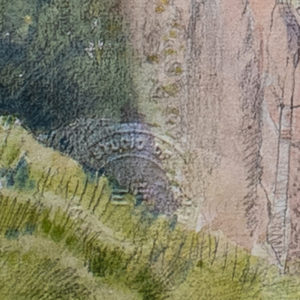
Eleanor Mary Hughes (née Waymouth) (1882-1959) was born in Christchurch where the family home was the celebrated Mona Vale. Her mother Alice encouraged both Eleanor and her sister Biddy to develop their artistic interests. She studied at Canterbury College School of Art and with C.N. Worsley between 1901-03. She exhibited at the Christchurch Society of Arts in 1902 before leaving for England in 1904 to attend the School of Painting and Drawing run by Stanhope Forbes and Elizabeth Forbes in Newlyn.
A brief return home consolidated her New Zealand reputation, but she left again for England in mid 1907 to study at Frank Spenlove’s Yellow Door Studio in London, before returning to Newlyn. She married a fellow Newlyner, Robert Hughes in 1910, and gradually became one of the stalwarts of the Cornish school, specialising in watercolour landscape and later in etching.
The couple designed and built their own home, Chyangweal, near St Buryan and the house became a regular social centre for artists settled in the area. Eleanor Hughes was a skilled pianist and would lead recitals at their home. In Cornwall the couple became lifelong friends with Laura Knight and her husband Harold Knight, who painted their portraits on a number of occasions.
The Cornish landscape and in particular the Lamorna Valley provided inspiration for Hughes’ works. She purchased her own studio and exhibited regularly from 1911 at the Royal Academy and eventually with the Royal Institute of Painters in Water Colours. Few members of the Cornish schools specialised in watercolour, but its qualities suited Hughes’ vision very well. She delighted in the scenery of her adopted region, West Penwith, and its key characteristics are always recognisable in her landscapes. Hughes became known, along with Lamorna Birch, as the essential illustrators of that area.
Maud Sherwood
Maud Winifred Sherwood (née Kimbell) (1880-1956) was born in Dunedin and moved as a child to Wellington in the early 1890s. She began exhibiting with the New Zealand Academy of Fine Arts in 1898 and won a travelling scholarship in 1902. Deferring this opportunity, she chose instead to become a teacher at the Technical College under James Nairn, whose position she assumed on his death in 1904.
Her first solo exhibition opened at the McGregor Wright Art Gallery, Wellington, on 16 April 1910. In late 1911 she left New Zealand and after a brief stay in London went to Paris where she visited artists’studios with Frances Hodgkins. She then studied at the Académie Colarossi, one of the best-known art schools in Paris, where Frances had taught, and soon after moved to Percyval Tudor-Hart’s studio. In the summer of 1912, she toured southern England in a sketching group organised by Tudor-Hart which included fellow expatriates Owen Merton, Cora Wilding and C.Y. Fell.
The following summer Sherwood visited the small fishing port and artist mecca of Concarneau, Brittany. It may well have been recommended to her by Hodgkins, who had spent the summer of 1911 painting in the picturesque fishing village. Whilst staying there Sherwood also met Cantabrian expatriate Sydney Lough Thompson, who was resident in Concarneau during this period.
Sherwood was greatly inspired by the subjects that Concarneau offered which included the marketplace, the locals in their historic vernacular costumes, the apparently ungoverned urchins of the town, the warm beaches and the fishing port.
Fishing Boats at Concarneau reflects the enthusiasm expressed by Sherwood for the small fishing village. Inspiration seemed to abound, and she wrote in her letters home:
‘The boats are gorgeous things with orange and brown sails and one I saw was a canary yellow and another almost an emerald green. Just imagine these all clustered together with the sun shining on them’.
The vigour of the present subject matter is cleverly underpinned by the square format chosen by the artist. This painting exemplifies what critics expressed of Sherwood’s work on her return to New Zealand as ‘her coat-off freedom of treatment’ (Evening Post).
Sherwood left Europe in October 1913 and settled in Sydney, where she became a regular exhibitor. An unhappy marriage made in 1917 came to an end in 1922, whereafter she exhibited and travelled extensively. She spent several years working abroad and returned to Australia permanently in 1933.
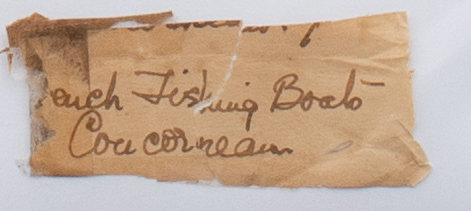
Amy Krauss
To Hannah Ritchie and Jane Saunders, 1 May 1923, Studio, St. Lawrence’s Street, Burford, Oxon
‘Amy Krauss suggests coming for the summer with a crate of Pottery & her wheel & setting up business & teaching – I am finding her a shop front. It will be invigorating for Burford’.
Amy Krauss RWA (1876-1961) was born in Bristol to a German father and an English mother. She studied at the Royal West of England Academy, becoming a founding member of The Clifton Arts Club. Although she is known to admirers of Frances Hodgkins in her later role as a potter, Krauss began her artistic career as a painter in both oils and watercolours.
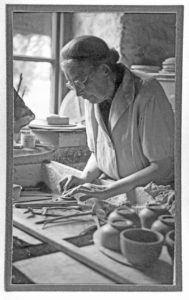
The Potter, Amy Krauss
E H McCormick Papers, E H McCormick Research Library, Auckland Art Gallery Toi o T¯amaki, gift of Linda Gill, 2015
No products were found matching your selection.
-
Amy Krauss
The Orchard
Watercolour 13 x 16.5 cm Signed lower right Exhibited Royal West of England Academy 1919 #683 Provenance Roger Peers, Beaminster Dorset
Krauss exhibited regularly from 1904 until 1914, chiefly landscape paintings. She studied art at the Académie Colarossi, Paris between 1908 and 1913, where it is believed she first met Frances Hodgkins. She returned to Bristol at the outbreak of war and worked as a draftsman for the British and Colonial Aeroplane Company. A clear influence on her aesthetic came from the Scottish colourists Samuel Peploe, J.D. Fergusson and Leslie Hunter, whom she came across while in Paris before the War.
Krauss joined Hodgkins’ sketching class in St Ives in September 1915. The Apple Tree, which was exhibited in 1917 at the Royal West of England Academy is characteristic of Krauss’painterly works. Krauss preferred outdoor scenes, whether in Britain or France. This work indicates clearly how Hodgkins’ loose shaping of forms and reliance on colour influenced Krauss’ watercolours, though it retains the imprint of the French work she would have seen in Paris a few years earlier.
Krauss painted with Hodgkins again at Burford in 1923, by which time, however, she had turned to pottery as her primary medium. Her interest in pottery grew as she collected several ‘peasant ware’ pieces on her travels abroad. She established her pottery career by first working for Fishley Holland Pottery, Devon, and later sharing a studio with Sibley Pottery, Wareham, Dorset. Finding success in Burford after setting up a small shop selling her pottery in the summer of 1923, Krauss established a permanent studio in a barn on West Street, Corfe Castle. She used locally sourced Wareham clay and grog, firing her pieces in an oil-fired kiln.
Krauss became one of Hodgkins’ closest friends and supporters. Hodgkins often stayed with her at her home, Redlane Cottage in Corfe Castle, and in August 1941 Krauss made the trip to Katharine & Anthony West’s farm to collect Hodgkins after recent surgery. She cared for Hodgkins at her home until she was well enough to return to her studio cottage later that year. Krauss was also instrumental in introducing Hodgkins to Elsie Barling and Dorothy Selby who would remain amongst her closest friends.
Krauss’ first major pottery exhibition was held at Lefevre Galleries, London, in 1925. Beautiful though they are in their small-scale perfection, the pieces illustrated here are not typical of Krauss’ceramic style. From the beginning of her interest in ceramics, in 1918, she tended to a cottage or peasant style, based on an admiration for French and Italian domestic pottery. She was more likely to produce vessels of domestic utility such as bowls, jugs and dishes, as can be seen in the photograph of her at work around 1940. There is a common factor, however, in the small scale, necessitated by the modest working set-up that she established for herself in Corfe Castle.
Beatrice Seddon
From Frances Hodgkins to Will Field, 30 March 1918, Wharf Studio, St Ives
‘The other day 3 nice girls, all from N.Z., blew in to the Studio – Miss Denniston of Peel Forest, Barker ditto & Beatrice Wood from Chch, a bright fair haired girl with a fluffy dog in her arms. She wanted me to paint her a sketch of herself for her Dad – Wiliam Wood – which I did! ... She is a masterful young person – of the nice sort, & I would like to adopt her’.
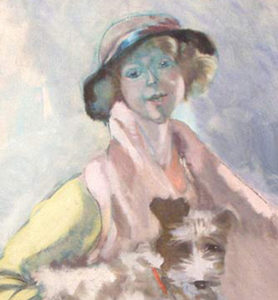
-
Beatrice Seddon
Haystacks and Poppies, The Cotswolds
Watercolour
30.5 x 45.5 cm
Provenance
The Artist’s Estate
Exhibited
The Seddon Collection, Jonathan Grant Galleries 2001
Beatrice Ann Seddon (née Wood) (1889-1987) was born in Christchurch on July 28th 1889, the third child of William Wood and Mary Theresa Loughnan. Seddon was educated at Rangi Ruru Girls’ School, attended a finishing school in England and upon returning to Christchurch attended art school under the tutelage of Sydney Lough Thompson and Margaret Stoddart. She went to London at the outbreak of war where she served as a volunteer Red Cross ambulance driver with the Aotearoa Club at Codford on Salisbury Plain.
Having contracted measles at Codford, Seddon went to St. Ives to recuperate, where she met and befriended Frances Hodgkins. While in St Ives, Hodgkins painted a portrait of Seddon (commissioned by her), titled Portrait of Miss Beatrice Wood, 1918.
Seddon joined Hodgkins’ painting classes at Porlock, Somerset and the following summer she organised a class for Hodgkins at Great Barrington in the Cotswolds. Frances wrote of the classes to her mother;
‘ … did I tell you that Bee Wood is working up a class of 6 or 7 at a small village in Oxfordshire & that I have promised to go on there on August 4th & give them lessons till the end of September’.
Like Hodgkins, Seddon dedicated herself to the medium of watercolour. Haystacks and Poppies, The Cotswolds clearly illustrates Hodgkins’ influence on her works. Made under Hodgkins’ tutelage in the summer of 1919, when a handful of keen students gathered in Great Barrington, eschewing the village’s obvious motifs of the old church, historic Fox Inn and picturesque stone houses, in favour of the beautiful Cotswold en plein air landscape.
In Haystacks and Poppies Seddon has achieved a pretty yet fresh example of the typically idyllic rural view popular in Britain (and New Zealand) since the mid 19th century. Her rapid touches of pigment in the foreground to indicate the eponymous flowers, contrasting effectively with the broad washes of the sky, show her to be no ordinary amateur, and she remained capable of this effortless charm over the years.
In 1921, Seddon married a son of the former New Zealand Prime Minister Richard Seddon. A frequent exhibitor throughout New Zealand, she was a popular artist and sales of her watercolour landscapes and still lifes supported her family through the depression years. She became well known as an artist and in 1971 she travelled to Norfolk, England to view the exhibition Flower Paintings of the World, where one of her own flower studies had been selected by the National Art Gallery to represent New Zealand.
Frances Hodgkins
From Frances Hodgkins to Rachel Hodgkins, c. Nov 1917, The Wharf Studio, St Ives
‘... Am going to spend the week end at Penzance with the Hellyers who have taken the Bolithos’ big old Tudor House & are giving a house warming. The only fly in the ointment is that I have so few clothes – attrition has gone on steadily since the outbreak of war’.
-
Frances Mary Hodgkins
The Little Wine Shop c. 1919
Watercolour 44 x 31 cm Signed lower left, Frances Hodgkins Inscribed below mount ‘The Little Wine Shop’ Inscribed verso 'No.10 The Little Wine Shop’ Provenance Mr W. J. P. Hodgkins Mr M. Hodgkins From the collection of Mrs W N Pharazyn (neé Field, a niece of Frances Hodgkins) Exhibited Grosvenor Gallery, London October 1919 International Society 26th Exhibition, London 1919

In September 1914 Frances Hodgkins was based in Le Faouët in Brittany, but decided to return to England and settle in St Ives, Cornwall at the outbreak of war. She remained in the small fishing village for most of the war, apart from brief summer stays in Chipping Campden, Exeter, Burford, Porlock and Penzance in south-west England. She hoped to establish herself as an art tutor and continue the success she achieved in Paris with her School for Water Colour. Indeed, her first comment about her new Porthmeor studio was ‘that it will do very nicely for a Class – not pretty but useful’.
By January 1915 she had established her studio and wrote to her mother, ‘I start teaching next week with three pupils and more to come … I have one local pupil – a nice woman who is going to be a great help to me in many ways – she has a glorious collection of old china & has given me a carte blanche to borrow it when so disposed’. Hodgkins’ initial flurry of activity was disrupted by war time restrictions and coastal sketching bans.
Severe food shortages and a decline in student numbers during the winter of 1917-18 placed significant strain on her. Things perked up in March 1918 when three students, ‘all from NZ, blew in the Studio’, one of which was Beatrice Wood. With war over and the sketching ban lifted, there were plenty of artist visitors to St Ives interested in lessons. She left St Ives at the end of 1918 and returned to her studio in London.
The work illustrated here belongs to a select group of watercolours painted by Hodgkins during post-war uncertainty and experimentation. Other works in this series include, Seaside Lodgings (Private collection) and My Landlady (Auckland Art Gallery Toi o Tāmaki), both exhibited alongside The Little Wine Shop at the International Society exhibition in the autumn of 1919.
Hodgkins lightness of touch employed here belies the intensity of detail observed and the highpoint of depiction is the appealing little dog doing its best to pass unnoticed. The guiding inspiration for this watercolour seems to have been the work of Hodgkins’old favourites Edouard Vuillard and Walter Sickert, but the end result is very much her own. Hodgkins’progression from impressionism to post-impressionism, whilst in St Ives, and her interest in decorative details are clearly visible in this composition. This work did not reappear at exhibition after 1919, as its original companions did, and was instead acquired by Hodgkins’ brother William Hodgkins, who held the work in his collection until his death in 1945.
From Frances Hodgkins to Rachel Hodgkins, 8 June 1919, Charlton Arms – Ludlow – Salop
‘It is a great old place, grandly situated on a hill top, on the borders of Wales. In one of the towers of the Castle the two little Princes lived till wicked Uncle Richard took them away. I have a room facing on the river, a tiny attic of a place very hot, & I have to cook my own breakfast, tea & supper, on a spirit lamp, getting my midday meal at the Charlton Arms just across the river’.
-
Frances Mary Hodgkins
Ludlow Castle c.1919
Watercolour on paper 23 x 23 cm Signed lower right Exhibited Grosvenor Gallery, London October 1919, # 382 Hampstead Art Gallery, London 1920, # 29
The war years had been a challenging time professionally, financially and emotionally for Hodgkins. Seeking to re-establish the success she had achieved in France, Hodgkins arranged a sketching class in the market town of Ludlow, Shropshire in the summer of 1919. She spent two months teaching a group of six students in the small village, taking in different views of the town.
The present watercolour was exhibited at the International Society 26th Exhibition at the Grosvenor Gallery in October 1919 and at the Hampstead Gallery the following year. The painting depicts Dinham Bridge with the ruined medieval fortification standing on a promontory overlooking the River Teme. Her works during this period illustrate Hodgkins’ inclination to move away from the animated colour and interest in light of her earlier Impressionist landscapes towards a more structured composition and restricted colour effect. The paint is thinly washed over an initial drawing in a range of closely related hues.
A similar work Landscape (Ludlow Castle) 1919, currently in the collection of Auckland Art Gallery Toi o Ta¯ maki, depicts the scene illustrated here from an alternate view. The bridge was a popular artist haunt and Hannah Ritchie, one of Hodgkins’ closest friends, also depicted this scene. Sketched two years earlier, Ritchie had sent her sketch, Bridge with Distant Landscape Seen Through One of the Arches (Auckland Art Gallery Toi o Ta¯ maki), to Hodgkins for appraisal.
Karl Hagedorn
From Frances Hodgkins to Karl Hagedorn, 6 March 1932, The Nook, Bodinnick-by-Fowey, Cornwall
‘My Dear Karl I found time, after I saw you, to look in at the “National” to see yr. drawings - and very good they are too - I spotted them at once, well hung & honoured as they should be. The person who can do work like that can do better still given the right mood & place & I see you going far on those lines ... I think you have got onto something very sound - even lovely later on when you decide on letting yourself go’.
-
Karl Hagedorn
Design with Bird Motif
Gouache on paper 29.8 x 19.8 cm Signed upper right Illustrated Karl Hagedorn, Rhythmical Expressions (Liss Llewellyn 2018) p. 91, no. 52 Exhibited Pallant House Gallery, Chichester September 2018 – February 2019 Provenance Estate of Karl Hagedorn
Karl Hagedorn RA (1889-1969) was born in Berlin and settled in the northern English city of Manchester in 1905 where he studied textile production and design. Hagedorn became a leading figure in the Manchester art scene, showing regularly at the Society of Modern Painters, exhibiting there from 1913-16, in London at the New English Art Club from 1913 and the Royal Academy from 1931-61.
In pre-war Paris he studied with Maurice Denis at the Académie Ranson, where he acquired a reverence for Henri Matisse and absorbed avant-gardism. On his return to England, Hagedorn made a consciously pioneering attempt to introduce Modernism into Manchester through his work as both painter and designer. He became a British subject in 1914 and served as a Lance Corporal in the Middlesex Regiment during World War I.
Hagedorn met Frances Hodgkins in 1923 in Manchester while she was staying with close friends Hannah Ritchie and Jane Saunders. Hodgkins was appointed a textile designer in 1925 and her burgeoning friendship with Hagedorn inspired a cubist tendency in her work. Hagedorn and Hodgkins remained close friends and supporters of each other for many years, a friendship which resulted in the acquisition by Hagedorn of Hodgkins’ chalk drawing, Cassis Quarry Man & Wife, painted during her visit to Cassis in 1920. Hagedorn left Manchester and relocated to London in 1927 where Hodgkins visited the artist and his wife at their new home.
Elsie Barling
From Frances Hodgkins to Hannah Ritchie, 14th March 1925, 61 Earls Court Square, SW5
‘Did I tell you Miss Barling has 4 good canvases at the W I A C – in fact the best in the show – my private view. She must show in a more modern gallery’.
-
Elsie Barling
A Moonlit Fishing Port
Oil on canvas 51 x 66 cm Signed lower left Provenance Roger Peers, Beaminster Dorset
Elsie Barling (1883-1975) was born in Newnham, Gloucestershire. Following the deaths of her brother and father, the family moved to Kent where she became a school teacher. Barling began an enduring friendship with Frances Hodgkins after being introduced to her by Amy Krauss. Barling later joined Hodgkins’ sketching class in Burford in the summer of 1923, accompanied by her close friend Dorothy Selby.
An occasional exhibitor, Barling had a devotion to painting that was limited by her need for steady employment as an art teacher. She taught at Betteshanger and Bryanston schools and as a teacher was spoken of with great affection and admiration. Full time employment left only school holidays for her own professional development. This meant that she was in many ways more disciplined than artists who were free from external commitments.
In 1927 Barling and Hodgkins visited Tréboul, Brittany and were joined by Dorothy Selby, Hannah Ritchie, Jane Saunders, Cedric Morris and Lett Haines before moving on to Concarneau. While Barling was fourteen years Hodgkins’ junior, the two evidently had a sincere friendship but there is every indication that Barling was her own person when it came to her painting.
Barling exhibited alongside Hodgkins at St George’s Gallery, London in 1928. Hodgkins wrote of the exhibition to Dorothy Selby;
‘The St George’s Gallery has written to ask me for 2 Water Colours to be sent in by the 25th … hope Barling will be prepared – but then, curse her, she always is’.
The artist’s documented statement that she and Hodgkins often went together to Brittany and southern France does not mean that they painted the same subjects in these locations nor that they adopted a similar style. In locations common to them both (Brittany, Cornwall, Tossa de Mar), it is clear that Barling remained committed to form in a way that Hodgkins did not – a point well illustrated by the present work, A Fishing Port. This work also hints that Barling had paid some attention to the post-war trend in France known as the‘retour à l’ordre’or return to order, which eschewed expressionism of any kind for a sense of structure.
Their lifelong association had a profound effect on Barling. In an interview with June Opie in 1969, Barling stated;
‘She was about the most interesting person I knew. I lived a very plainish (ordinary) kind of life. Taught painting at big schools, at Bryanston and places, you see, and if I hadn’t met her I shouldn’t have gone abroad so much, probably. And I met all sorts of interesting people through her. I think she gave me more of an open mind altogether’.
A memorial exhibition of Barling’s work was shown at the Dorset County Museum, Dorchester in 1977.
Gwen Knight
Gwen Knight (1888-1974) was born in Wellington and lived on The Terrace above Woodward Street, before moving at the age of four to Hunters Hill in Sydney. Knight studied music at the Sydney Conservatorium and went to Europe in 1913 to further her career as a pianist.
It is no exaggeration to say that meeting Frances Hodgkins changed Gwen Knight’s life. She joined Hodgkins, along with fellow New Zealand artist Flora Scales, in St Tropez in 1931. Painting had always been a second love for Knight and through the encouragement of Hodgkins, she decided to pursue her career as a practicing artist.
Hodgkins introduced Knight to Hans Hofmann in Munich, who after seeing her work took her on as a pupil. A highly perceptive and sympathetic teacher, Hofmann emphasised the essential discipline of drawing and it is this that Knight always referred to as one of her most important influences. The artistic atmosphere of Europe in the twenties and thirties, enhanced by the long and happy friendship with Hodgkins, had a profound effect on Knight’s work. Her chief interest became landscape painting, informed not only by Hodgkins’ example (in the use of gouache), but also by the teachings of Parisian artists André Lhote and Roger Bissière under whom she studied.
Flora Scales
Helen Flora Victoria Scales (1887-1985) was born in Lower Hutt, Wellington. Her father encouraged her artistic talent, taking her to London in 1908 for four years training at William Frank Calderon’s School of Animal Painting. Her study concluded with the hanging of one of her works in the Summer Exhibition at the Royal Academy of Arts in 1911.
After her return to New Zealand, Scales joined the Academy Studio Club in 1914 and became a regular exhibitor at the New Zealand Academy of Fine Arts from 1906. She became identified in the New Zealand gallery-goer’s mind with animal painting (firstly) and modern landscape (later in life), the kind of subject matter seen in the work illustrated here.
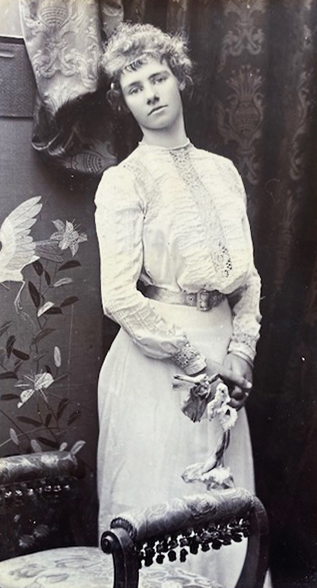
-
Flora Scales
Eastern Extension Cable Company’s Ship ‘Patrol’, Wellington Harbour, early 1920s
Watercolour
22.5 x 28.5 cm
Signed Flora Scales lower left
The popularity in Wellington of works such as this – watercolour on a modest scale depicting local scenery – was due in large part to the local influence of Dorothy Kate Richmond. Scales’ work, however, derives from quite a different art training and could not be mistaken for that of Richmond’s. The specificity of this watercolour’s content suggests a commission, though the circumstances of its production are today unknown.
In 1928 a bequest from her father enabled the artist to return to Europe, where she studied in Paris at the Académie de la Grande Chaumière. Scales first met Frances Hodgkins in Paris and later joined her in St Tropez in 1931, along with Gwen Knight, on a sketching trip. Knight urged Scales to continue her studies and suggested she enrol with Edmund Kinzinger at the Hans Hofmann School of Art in Munich.
Returning to Nelson in 1934, Scales met and inspired Toss Woollaston, before leaving New Zealand in 1936 to continue her studies at the Académie Ranson, Paris, and the Heatherley School of Fine Arts, London. During the 1950’s Scales’ handling of paint became more confident, with broader brush strokes and an increasingly atmospheric quality to her abstract landscapes.
In 1972 she resettled in New Zealand where she became recognised as a pioneering and remarkably independent painter. Her first solo exhibition was arranged by Colin McCahon at the Auckland City Art Gallery in 1975.
Kitty Church
From Frances Hodgkins to May Smith, Mar 1940 Studio – West St – Corfe Castle – Dorset
‘I am still in Dorset. It is not wildly exciting, but I have a Studio and when I want “picturesque” I go out & look for it. I have a Water Colour Show opening next week at Lefevres & feel it is up to me to put in an appearance. Kitty Church has just had a highly successful show there sold 13 small priced paintings & put herself on the map’.
Kitty (Katharine) Church (later West) (1910-1999) was born in London and expressed an early desire to paint. She trained at the Brighton School of Art, the Royal Academy Schools 1930-33 and the Slade School of Fine Art 1933-34. In 1933 she had her first solo exhibition with Lucy Wertheim’s gallery in London. She also exhibited with the New English Art Club and showed regularly with The London Group. From 1937 to 1947 she exhibited at Leferve Gallery, London.
In 1937 she married Anthony West, son of the writers Dame Rebecca West and H.G. Wells. The following year the couple moved to a farm in Berkshire where they were visited regularly by a wide circle of friends that included Frances Hodgkins, Ivon Hitchens, John Piper and his wife Myfanwy.
Hodgkins painted a number of works whilst staying with the couple, including Double Portrait No.2 (Katharine and Anthony West) now held in the collection of the Museum of New Zealand Te Papa Tongarewa. The Wests were also instrumental in Hodgkins’ recovery after surgery in 1941, collecting her from hospital and caring for her in their home during her convalescence. During her stay she wrote to Arthur Reid of Lefevre Gallery;
‘Friends have been wonderful. Kitty & of course Anthony have been darlings & helped me through difficult days after the operation. I can never forget what they did for me. It was ideal at their Farm on those hot September days. I lay out all day in the garden insight of their beautiful herd of cows, whose milk did the trick & built up my strength’.
-
Katharine Church
Self Portrait
Oil on board
Signed & dated 1994
Provenance
Estate of Katharine Church
-
Katharine Church
Eastbury Gates, Tarrant Gunville, Dorset
Watercolour
36 x 55 cm
Signed
Provenance
Estate of Katharine Church
Frances Hodgkins
From Frances Hodgkins to Dorothy Selby, 10 Jan 1933, Hotel Balear, Ibiza
‘I am still reacting pleasantly to Ibiza in the painting way and find heaps to do. All very lovely. I can hardly believe it. Weather much colder but fine today. Houses very cold & we seek bed or café in evenings to keep warm’.
Rée Gorer, mother of social anthropologist Geoffrey Gorer, became a great admirer and patron of Frances Hodgkins’ work, and it was her purchase of a painting that enabled Hodgkins in late 1932 to fund the last of her long continental journeys, south to Ibiza in the Balearic Islands, to escape the bleak British winter.
-
Frances Mary Hodgkins
Ibiza
Watercolour & gouache 49 x 37 cm Signed & dated 1934 Inscribed To Eve from Frances Hodgkins 10.10.34 Provenance Mrs Eve Disher (1894-1991) The Ruskin Gallery, Stratford on Avon The Peter Dingley Collection, London
Hodgkins was in Ibiza from October 1932 until the following July, meeting up with English artist Gwen Knight and New Zealander May Smith. Ibiza and Tossa de Mar, on the Costa Brava, were initially suggested as excellent venues for subject matter by Karl Hagedorn and his wife. Hodgkins enjoyed the island’s balmy climate, as well as its culture and history. Seeking not only new subject matter, but a more comfortable climate, she started work on a substantial new body of paintings to be shown at her first solo exhibition with Lefevre Gallery.
Hodgkins responded to the islands clear ivory light writing,
‘… things appear in stark simplicity minus all the detail – nothing corked up (bouchée) or hidden as in grey, or brown light of the North. Of course, later on, this intense sun light will convert colour & form into absolute negation but at the moment there is complete lovlieness. The pale coloured flat roofed houses without windows give a blind restful feeling, of immense space’.

From Frances Hodgkins to Rachel Hodgkins, 21 Dec 1920, Cassis – Nr. Marseilles
‘This place is off the beaten track, not very far from Marseilles, on the coast, much frequented by artists on account of the landscape. The little town is not up to much & the people are not very attractive. Winston Churchill, his wife & suite have been here lately, he for a fortnight’s painting ... It is a pity I missed him’.
-
Frances Mary Hodgkins
Cassis Quarry Man & Wife c. 1921
Black chalk 32 x 45 cm Signed Frances Hodgkins Provenance Estate of Karl Hagedorn RBA Exhibited Frances Hodgkins People, NZ Portrait Gallery, December 2017 - Feb 2018 Frances Hodgkins: European Journeys, Auckland Art Gallery Toi o Tāmaki, May - September 2019 Dunedin Public Art Gallery, October 2019 - January 2020, The Christchurch Art Gallery Te Puna o Waiwhetū, February - May 2020
After leaving New Zealand in 1901, the first group of monochromatic works that appear in Hodgkins’ oeuvre are related to Cassis, where she spent six weeks during the winter of 1920-21. Hodgkins’ drawings from this period were completed in black chalk and were of uniform size. Two examples of her chalk drawings are currently held in public galleries; Cassis c.1921 (Auckland Art Gallery Toi o Tāmaki) and Landscape in the South of France (Whitworth Art Gallery, University of Manchester).
Hodgkins left England for France in 1920. On her arrival, she immersed herself in the local culture, enjoying the fine French food and wine. After a week of relaxation she moved south to the small town of Cassis in the hope of meeting up with close friends Cedric Morris and Lett Haines. Arriving in the fishing port, Hodgkins discovered that they had already departed, but the magnificent amphitheatre created by the hills surrounding Cassis drew her in, and she decided to stay.
Intending to produce a set of black-and-white drawings for exhibition and possible reproduction, Hodgkins settled upon the local landscape and the colourful characters for subject-matter, obviously relishing the strong- featured physiognomies around her and the hidden depths of her medium. She enjoyed daily walks over the rugged hills of the region and sketched constantly as she went. This, Hodgkins realised, was Cézanne country – a challenge that she met in a series of black chalk drawings, which are notable for their boldness and strength of design – in what was for her, a new medium.
-
Frances Mary Hodgkins
Pumpkins
Collotype
52 x 70 cm
Published by Ganymed, 1952
Illustrated Ganymed Facsimiles, London, April 1950. p.18
The image used to produce the present original collotype “Pumpkins” is that of the gouache Pumpkins and Pimenti (circa 1935) owned at the time by Sir Kenneth Clark, Director of the National Gallery, and now held in the collection of The Fletcher Trust.
With financial assistance from Rée Gorer and Dorothy Selby, Frances Hodgkins spent the winter of 1935 – 36 in Tossa de Mar where she painted the gouache Pumpkins and Pimenti which is closely related to Marrows a work that featured in the 2019 Jonathan Grant Galleries exhibition Frances Hodgkins – A New Zealand Modernist.
Frances Hodgkins to Dorothy Selby. Casa Steyer Tossa de Mar Gerona Spain Nov 1935
I paint during the morning – dividing my time inside & outside the Studio. This is the very charming part of a place like Tossa. So small & simple one can step into the old streets and have a look round – make a quick sketch & back to the Studio. Repeating this little stunt perhaps 2-3 times during the morning – no fatigue – no complications. I am mildly happy here as regards work. Subjects have come slowly. I still think it rather a middling sort of place ideal in summer – for a good time & holiday
John Piper
From Frances Hodgkins to John Piper, c. Sep 1941, Studio, East St, Corfe Castle, Dorset
‘I am looking forward eagerly to tomorrow’s Spectator & your verdict of the Show, ... I look for severity as well as gentleness & wisdom & wit in all you write. I can only make a feeble guess at all that you have done to make my Show a living valid thing. What time I have been eating my heart out down here because I can’t see my own darling Show’.
No products were found matching your selection.
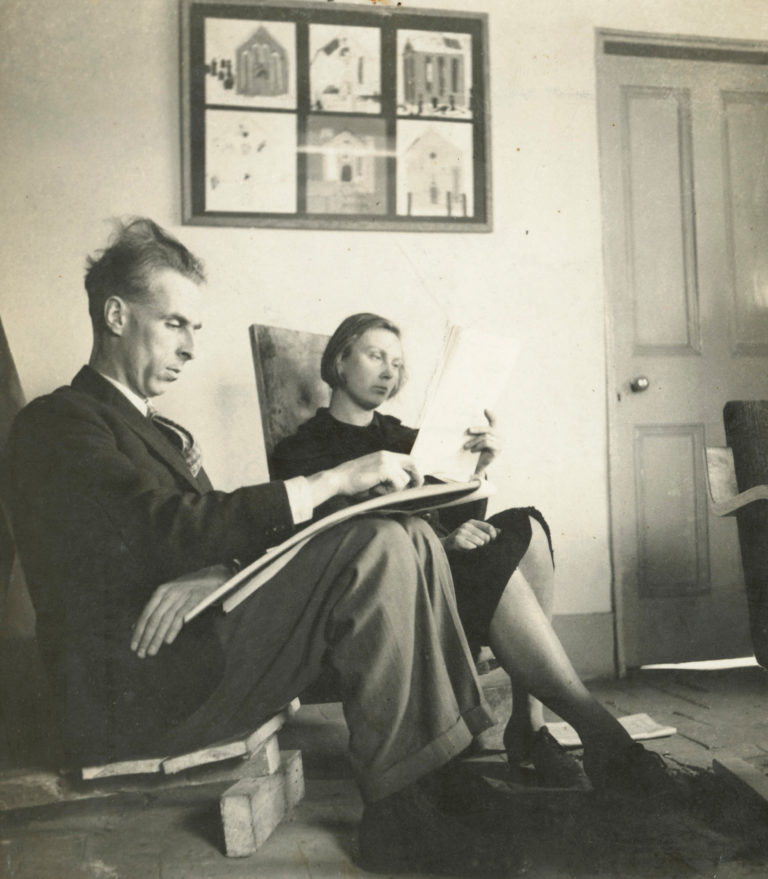
John Egerton Christmas Piper CH (1903-1992) was born in Epsom, England, and educated at Epsom College, the Richmond School of Art and the Royal College of Art, London. In the early 1930s Piper exhibited with the London Group and became secretary of The Seven & Five Society which included Henry Moore, Ivon Hitchens, Ben Nicholson and Barbara Hepworth. It is believed he met Frances Hodgkins through the society when she was elected a member in 1929. The influence of The Seven & Five Society is clearly evident in Piper’s work, seeing him embrace a number of media, including painting and print-making.
Piper, together with writer Myfanwy Evans, founded the contemporary art journal Axis in 1935. It was through his work as an art critic for The Listener, his work on Axis and his membership with The Seven & Five Society, that Piper was at the forefront of the modernist movement in Britain throughout the 1930s. By the late 1930s Piper had returned to a more naturalistic style. He concentrated on landscape and architectural subjects in an emotionally charged approach that was a continuation of the nineteenth century English Romantic tradition.
At the outbreak of the Second World War, Piper was commissioned by Sir Kenneth Clark and the War Artists’ Advisory Committee to capture the effects of the war on the British landscape. The devastation of the Blitz was easily assimilated to Piper’s personal interest in old ruined buildings. Cascade Bridge, Halswell is typical of what Piper is famous for in Britain; his war-time work, documenting bombed churches, most notably in Coventry, Bath and Bristol. The resulting work utilised to great effect his interests in architecture, abstraction and printmaking. The subject here also illustrates Piper’s other, closely related, major subject matter of country houses and estates, also victims of deterioration. He had a sell-out exhibition in 1940 at the Leicester Galleries, featuring several works of derelict ruins.
Piper & Evans married in 1937 and became two of Frances Hodgkins’ closest friends in the latter period of her life. Piper regularly wrote to Hodgkins and reviewed her exhibitions exclaiming on one occasion, ‘Frances those paintings are knock-out’ after viewing her 1941 Leicester Galleries exhibition.
Bronwynne Cornish
“These three still-life groups have been sourced from Frances Hodgkin’s paintings. Frances herself would often, while staying at the homes of friends, sketch jugs and vases that caught her eye. Back in her studio she would compose still-life groups from these drawings, often using a favourite item in more than one painting. Likewise, I have chosen my favourites from Frances Hodgkins’ paintings and composed my own groups. I particularly like that she used a shoe in ‘Self Portrait’ – to represent herself.”
Bronwynne Cornish, 2017
-
Bronwynne Cornish
Vase, Shoe, Dahlia
From the Frances Hodgkins ‘Self Portrait’ series
Inspired by the art of Frances Hodgkins
White slip over red clay
470 x 200 mm
Unique
Bronwynne Cornish is one of New Zealand’s best known ceramic artists. She is an important figure in the recent history of New Zealand ceramics, in her role as both an artist and a teacher.
Since beginning to work in clay in 1968, she has developed a practice which is largely sculptural, including man installations and large works. Her central themes reflect a strong interest in place, ritual and mythology.
Cornish represented New Zealand at the Brisbane triennial in 1996 and had a solo show at the Auckland Art Gallery Toi o Tamaki in 2002.
In 2014 a major survey of Cornish’s work between 1982 and 2013, titled Mudlark, was organised by MTG (Museum Theatre Gallery) Hawkes Bay and also shown at the Gus Fisher Gallery in Auckland. In 2015 this exhibition showed at the Dowse Art Museum in Lower Hutt.
Cornish’s career spans over 45 years and her work is held in many public collections, including the Auckland War Memorial Museum, the New Zealand Ministry of Foreign Affairs & Trade, The Wallace Collection, the Museum of New Zealand Te Papa Tongarewa and the Kobayashi Collection, Tokyo.
Cornish notes –
“I make work that I hope will create a certain atmosphere, ring a long-lost bell and help people create their own mythologies.”
–
We are grateful to Dr Pamela Gerrish Nunn for her assistance in compiling the catalogue entries



